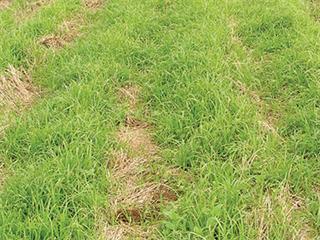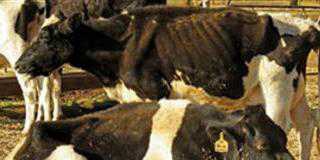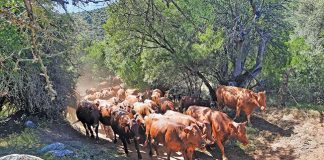
At the KwaZulu- Natal Department of Agriculture and Agricultural Affairs’ (KZN DAEA) Cedara Agricultural Research Centre, Dr Suzette Bezuidenhout conducted experiments to determine the allelopathic effects of various parts of common
oats, stooling rye and annual ryegrass on the yellow nutsedge (Cyperus esculentus) weed that plagues many South African crop farmers. In all the experiments, cover crops were grown to maturity and then killed off with a glyphosatebased herbicide before the different dead and dried plant parts were used.
Beneath the soil
For all three cover crops used in a tunnel experiment, roots had the greatest growth reduction impact on the yellow nutsedge. While the mulched leaves of the cover crops inhibited yellow nutsedge growth to a significantly lesser extent
than the cover crops’ roots did, the weed’s growth was still less than that of the control where the yellow nutsedge grew without competition.
However, when the cover crops’ leaves were soaked in water for 24 hours, rinsed and then placed on the soil surface, yellow nutsedge growth in the common oats and stooling rye pots was actually enhanced to a stage where it outgrew the weed in the control pots. Weed growth in the annual ryegrass pots was significantly less compared to the other two cover crops but was still almost the same as yellow nutsedge growth in the control pot.
Comparing the effects of the annual ryegrass cultivars, Agriton, Midmar, and Sophia, on yellow nutsedge growth (see Graph 1), the roots again had the greatest inhibitory effect. Mulched leaves had a lesser inhibitory effect. However, in the soaked leaves treatment,the Agriton and Sophia annual ryegrass cultivars seemed to enhance yellow nutsedge growth beyond that in the control pots, while the Midmar cultivar reduced at the rate of weed growth compared to the control pot.

The allelopathic effects of parts of the Agriton, Midmar and Sophia annual ryegrass cultivars on the growth of the yellow nutsedge weed.
Maize growth
While the experimental results were good news for Bezuidenhout, the results of a similar experiment – seeing how the same cover crops would affect maize plant growth – were cause for concern. Compared with the control pot of maize growing with no competition, the roots of the common oats, stooling rye and annual ryegrass had a significant inhibitory effect on maize growth (see Graph 2). The mulched leaves of common oats and stooling rye had almost no effect on maize growth, whereas the mulched leaves of annual ryegrass significantly inhibited maize growth.

The allelopathic effects of parts of oats, stooling rye and annual ryegrass, on the growth of maize.
Only the soaked leaves of the trialed cover crops had no impact on the maize plants. For the various plant parts of the Agriton, Midmar, and Sophia annual ryegrass cultivars, it was once again the roots that had the most powerful allelopathic effect. In the mulched leaves treatment, only the Sophia cultivar had little inhibitory impact on maize growth.
In the soaked leaves treatment, Midmar had no effect on maize growth, in contrast with Agriton and Sophia that significantly enhanced maize growth. Bezuidenhout’s testing of the allelochemical content of the three annual ryegrass
cultivars seemed to bear out what had been witnessed in the experiments.
The Midmar cultivar contained 14 parts per billion (ppb) of ferulic acid, 440 ppb of hydroxybenzoic acid and 20 ppb of Benzoxazolin-2(3H)- one (BOA), which are all allelochemicals. The Agriton cultivar had no ferulic or hydroxybenzoic acid content, and only 5 ppb of BOA content. The Sophia cultivar contained no ferulic acid, only 15 ppb of hydroxybenzoic acid,
and 4 ppb of BOA.
“The results of these pot experiments answered our question as to the ‘how’ of using cover crops to control weeds,” Bezuidenhout says. “The next step was to determine the ‘when’ of cover crop use to control weeds. By using chemical
herbicides as a shortterm weed control option farmers can choose to apply preplant, pre-emergence and post-emergence herbicides. Using cover crops to control weeds is not a simple on/off switch to complement herbicide use as an integrated, longer-term, weed control programme.”
Bezuidenhout adds that farmers should bear in mind that the time residual herbicide effects remain in the soil will vary, depending on factors such as clay content, rainfall, and herbicide concentration, among others. The residual effects of allelochemicals produced and released by cover crops will also be affected by these factors and other events such as the timing of the release by cover crops and the chemical concentrations.
Read: The allelopathic effect
“For example, our field experiments found that the allelopathic effects of annual ryegrass plant residues lying on the soil between rows of maize plants were quite high against weeds, particularly yellow nutsedge, 16 days after the maize had emerged. “By 28 days, weed growth between the maize rows had increased significantly,” Bezuidenhout points out.
“The same situation developed with stooling rye residues. We know now that we have a weed problem after 28 days we rely solely on annual ryegrass and stooling rye to allelopathically control weeds in a maize crop. We also wanted to find out how to extend the allelopathic effects beyond 28 days.”
Bezuidenhout implemented another field experiment, still ongoing, where she planted a number of plots of either common oats or annual ryegrass as rotational cover crops before a maize crop. Some of the plots were sprayed with a glyphosatebased herbicide four weeks before maize was due to be planted into either the common oats or annual ryegrass crop residues. Some cover crop plots were sprayed with glyphosate two weeks before maize
plantings, and other cover crop plots were glyphosatesprayed immediately prior to maize planting. Control maize plots had no residues. (See graph 3)

Comparing the the allelopathic effectiveness of oats and annual ryegrass on weeds after the cover crops were sprayed with glyphosate at different periods before maize was planted into them.
Results of this experiment revealed that annual ryegrass sprayed with glyphosate just prior to the maize being planted gave the best weed growth control. This was in significant contrast to the common oats cover crop that was
glyphosate-sprayed just prior to the maize being planted. Weed growth in this latter plot actually exceeded weed growth in the control maize plot. “But I was still concerned about how maize plants and their grain yield would be affected by the various plot treatments,” explains Bezuidenhout.
“It turned out that the control maize plot yielded the highest at about 8,5t/ha of grain. “Interestingly, the maize in the annual ryegrass crop that was sprayed with glyphosate just before the maize was planted into it, yielded the lowest maize grain of all the trial plots at 5t/ha. In fact, all of the cover crop trial plots and their different treatments yielded less maize grain than the
control maize plots.”
Taking all the results into consideration, Bezuidenhout concluded that allelopathy does have the potential to control weeds. Yellow nutsedge could be controlled to varying degrees by the allelopathic characteristics of common oats, stooling rye and annual ryegrass. Furthermore, the roots of these cover crops had the greatest allelopathic effects on weed growth. It was discovered that the allelopathy of cover crops also had a negative impact on maize growth and yield.
Read: Coping with nutsedge
Trials showed that weed control for the duration of a maize production season could not be achieved through cover crop allelopathy alone. The maize farmer would still have to spray herbicide to optimally control the weeds. The length of time that cover crops were killed off using glyphosate before maize was planted into the residues, had an influence on the length of time that the cover crops’ allelopathic effects continued against weeds. These results confirmed that allelopathic crops should be used in conjunction with strategic herbicide applications for the best weed control.
Future research
“Many questions remain about how effective allelopathic cover crops are on weeds in if commercial crops. It must also be remembered that I conducted these experiments only at Cedara. Results could vary for similar trials elsewhere. But the results can be used by farmers, and other agricultural researchers, as building blocks on which to base their own experiments,” Bezuidenhout says.
According to her, farmers who want to incorporate allelopathy into their weed management programme need to consider climatic conditions, structural characteristics and nutrient content of soil, ideal cover crop species and cultivar for the conditions, and how the existing crop and weed management programmes are incorporating allelopathic cover crop use.
“But again, the bottom line is that allelopathy is only part of an integrated weed management strategy. You have to use it in combination with chemical and mechanical weed control programmes. Who knows? With ongoing scientific and
on-farm research, an improved programme for using allelopathy to control weeds could be developed one day.”
Phone Dr Suzette Bezuidenhout at 033 355 9408 or email [email protected]













